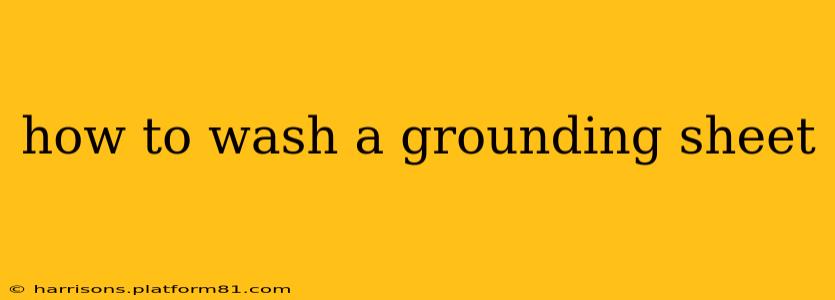Grounding sheets, also known as earthing sheets, have gained popularity for their purported health benefits, promoting relaxation and improved sleep quality. However, maintaining their cleanliness is crucial to ensure both hygiene and the longevity of the product. Washing your grounding sheet properly is essential, and this guide will walk you through the best practices. We'll cover everything from choosing the right detergent to proper drying techniques to ensure your grounding sheet remains effective and comfortable for years to come.
What are Grounding Sheets Made Of?
Before diving into washing instructions, understanding the material composition of your grounding sheet is key. Most grounding sheets are made from a blend of natural fibers, often including cotton, linen, or a combination of both. Some may also include a small percentage of synthetic fibers for added durability. Knowing the exact material composition will help determine the best washing method and prevent damage. Check the care label on your specific sheet for precise details.
How Often Should I Wash My Grounding Sheet?
Similar to regular bed sheets, the frequency of washing your grounding sheet depends on individual preferences and usage. However, it's generally recommended to wash your grounding sheet at least once every two weeks to maintain hygiene. More frequent washing may be necessary if you sweat heavily at night or if you have pets that sleep on the bed.
How to Wash a Grounding Sheet: A Step-by-Step Guide
1. Pre-Treatment (Optional): If you have any noticeable stains, gently pre-treat them before washing. A mild stain remover or a solution of baking soda and water can be effective. Avoid harsh chemicals that might damage the conductive silver threads.
2. Choosing the Right Detergent: Opt for a mild, plant-based, fragrance-free detergent. Harsh chemicals, bleaches, and strong fragrances can damage the conductive silver threads woven into the fabric and diminish the grounding effect.
3. Washing Machine Settings: Wash your grounding sheet in cold water on a gentle or delicate cycle. Over-agitation can damage the conductive threads and potentially shorten the life of your sheet.
4. Drying: Air drying is the recommended method for grounding sheets. Hang it to dry in a well-ventilated area, away from direct sunlight. Avoid using a dryer, as the high heat can damage the conductive silver threads and potentially melt or degrade them.
5. Inspecting After Washing: Once dry, carefully inspect the sheet for any signs of damage to the conductive threads. If you notice any fraying or breakage, contact the manufacturer for assistance.
What About the Conductive Silver Threads? Will Washing Damage Them?
Proper washing practices, as detailed above, minimize the risk of damage to the conductive silver threads. Using a mild detergent, cold water, and air drying are crucial to maintain the grounding properties of the sheet. However, keep in mind that repeated harsh washing or improper handling can eventually lead to degradation.
Can I Use Bleach on My Grounding Sheet?
No, avoid using bleach on your grounding sheet. Bleach can damage the conductive silver threads and potentially weaken the grounding effect. It can also cause discoloration and weaken the fabric.
Can I Put My Grounding Sheet in the Dryer?
It's strongly recommended to avoid using a dryer for your grounding sheet. The high heat can damage the conductive silver threads and potentially shorten the life of the sheet. Air drying is the safest and most effective method.
How to Maintain the Grounding Effect of My Sheet?
Besides proper washing, keeping your grounding sheet in good condition helps maintain its grounding effectiveness. Avoid sharp objects that could snag or cut the threads. Store it properly when not in use, preferably folded neatly rather than crumpled.
By following these instructions, you can ensure your grounding sheet remains clean, comfortable, and effective for a longer period. Remember to always check the manufacturer’s instructions for specific care recommendations for your particular grounding sheet.
